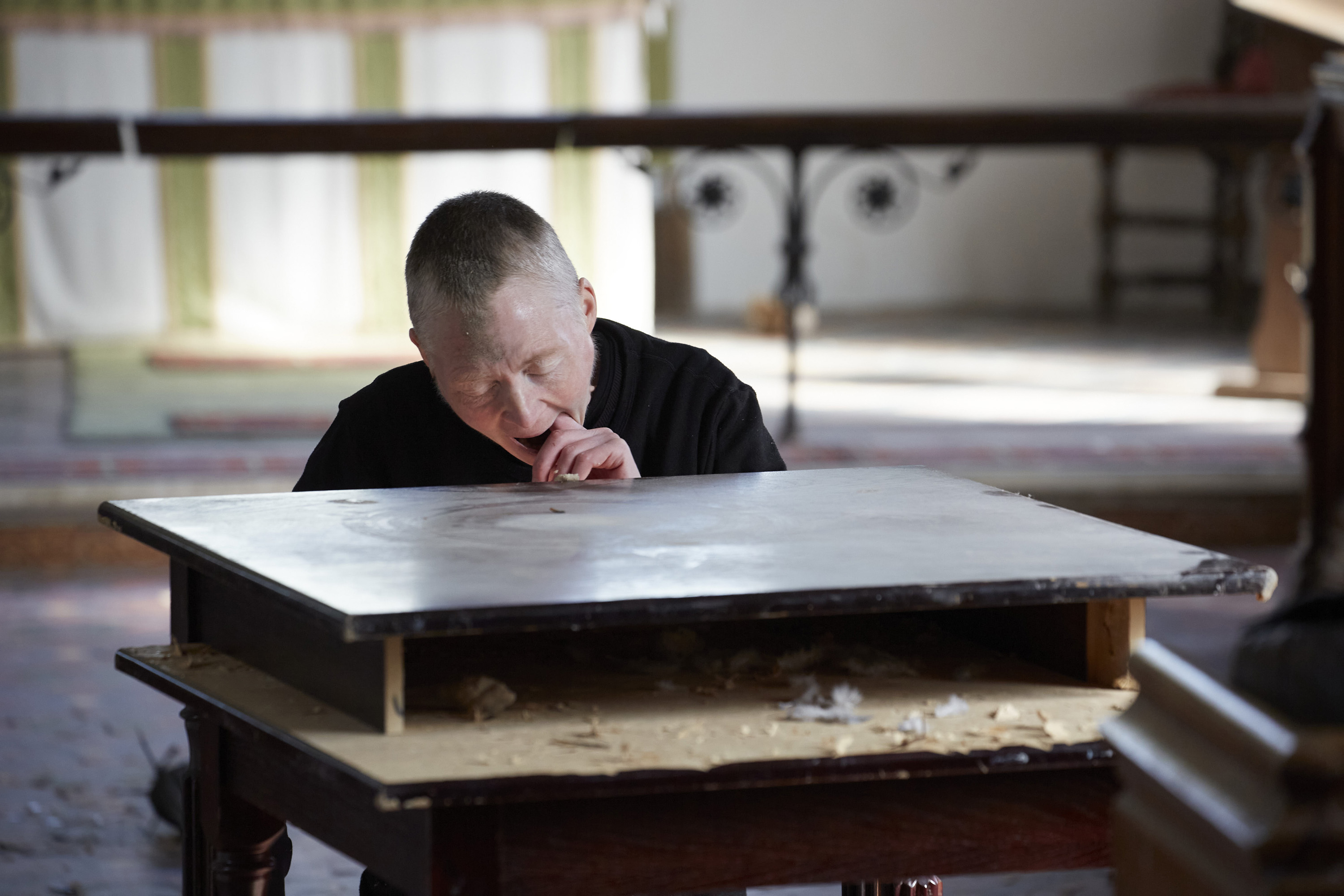Sara Sassanelli
Horizonless Hopes
This text is a response to Sandra Johnston and Monstera Deliciosa’s performances at TIDING (April 2022).
TIDING was a day of performance hosted by ]ps[ at two historic sites of worship in Folkestone and Romney Marsh. ]ps[ invited three writers - Madinah Farhannah Thompson, selina bonelli and Sara Sassanelli - to respond to the six works presented at TIDING.
︎︎︎ about TIDING
 Sandra Johnston. Photo by Tristan Broers.
Sandra Johnston. Photo by Tristan Broers.Tiding, I will drift with or as if with the tide. Drifting as an endless process of journeying, as an impossible arrival, as a refusal of ascension, as a refusal of greatness, as horizonless. As a response to these works, I would like to express uncertainty, to stick with ambivalence and to feel out the edges of language, as much as the works themselves did.
1.
Performance for me can be a venture into the horizons of hope, a look into a deprogramming of time that allows for a temporary unmasking of fraught and conditioned desire. Basically, performance can be a place to have a moment. To not have to deal with the things that are continuously thrown at our nervous systems that make things difficult. Performance could also just be a break from sacrificing a sense of self in order to make room for constricting desires. What could these horizons of hope look like, if they take a moment of respite from being trapped in language? With these works, I am reminded that language can bind feeling into a tighter form, and sometimes can’t do the feeling justice.
When watching performance, I would like to be like Neo/Trinity in that moment between being in the Matrix and waking up in the goo of the pod. The moment of suspension between the awakening and the not remembering. Desire and fear are coded almost identically in The Matrix, and are the mechanisms used to control Neo/Trinity as they yield the most energy-generating responses from them. This proposition that desire is a tool of control makes sense, as desire is often generated by external factors connected to forces of domination. When thinking about the pods, I think of the horizonless space surrounding them and the water below. Even more so present in Matrix: The Resurrection than in the first film; the sense of scale gestures towards the endless forms of exploitation but also, sneaks in a sense of hope in its nonlinear potential. To quote Andrea Long Chu ‘For to exit the Matrix is not to know the truth but to discover the poverty of knowledge. “Welcome to the desert of the real,” Morpheus intones after Neo takes the red pill. There’s a reason the real is a desert. What good is the truth if nothing grows there?’. To fight with desire, is to try and address its goodness or badness, and isn’t that a difficult and unfruitful task - isn’t this constant searching also feeding the energy-sucking machines of the present anyways? I would rather spend time trying to get under it, between it, or even sit uncomfortably in its cracks.
When watching performance, I would like to be like Neo/Trinity in that moment between being in the Matrix and waking up in the goo of the pod. The moment of suspension between the awakening and the not remembering. Desire and fear are coded almost identically in The Matrix, and are the mechanisms used to control Neo/Trinity as they yield the most energy-generating responses from them. This proposition that desire is a tool of control makes sense, as desire is often generated by external factors connected to forces of domination. When thinking about the pods, I think of the horizonless space surrounding them and the water below. Even more so present in Matrix: The Resurrection than in the first film; the sense of scale gestures towards the endless forms of exploitation but also, sneaks in a sense of hope in its nonlinear potential. To quote Andrea Long Chu ‘For to exit the Matrix is not to know the truth but to discover the poverty of knowledge. “Welcome to the desert of the real,” Morpheus intones after Neo takes the red pill. There’s a reason the real is a desert. What good is the truth if nothing grows there?’. To fight with desire, is to try and address its goodness or badness, and isn’t that a difficult and unfruitful task - isn’t this constant searching also feeding the energy-sucking machines of the present anyways? I would rather spend time trying to get under it, between it, or even sit uncomfortably in its cracks.
2.
In Johnston’s work, I think of language as a limit or a threshold, one that she replaces with gesture and action. The threshold becomes a space to disrupt, where ambiguity of interpretation is temporarily visible. Gesture here feels important, calculated but also with space for the unknown to emerge - and with that comes a sense of relief.
In both Johnston and Monstera’s work I am reminded of the possibility of a horizonless future, one that is more akin to embodied gesture, than descriptive language. Is a horizonless future perhaps a way out of being vulnerable to another’s desire? What if we were able to understand the dominant language of our desire as one so conditioned by the trauma of late capitalism, that investing in a settled, firm sense of self becomes a messy undesirable process of domination or elite capture? What could we imagine were we to be liberated from that? Not liberation in terms of a search for consensus or agreement, but a liberation fired up by a failure to define the self.
Watching Monstera sit at a church pew flipping through theory books - casually engaging with them, gripping and disregarding them - I am reminded of how the things I read stay with me, blend into my life or just pass through. In this context those theory books look heavy, but also comforting to think about the loud cacophony of thinking that is always going on, like a white noise.
Witnessing Johnston’s careful mastery of pace, decision-making and silent resistance makes me think of her embodied gestures as intimate knowledge she shares with the space, and the objects she is interacting with. A new constellation of relations and alliances emerges, reminding me of possibilities of porous solidarity through gesture, action and space. Watching her gestures becomes an exercise in trying to decipher the new constellations of relations in the room. Like trying to work out a mathematical equation that is closer to an exercise of the imagination, rather than a sum. In Monstera’s work, I think of the self as a flickering, oscillating ambiguous shape of ‘things to come’. One that is not about self-monitoring, or constant self-assessment, one that can get lost in the non-euclidian feeling of a dark room with no beginning and no end. Similarly, that is how Johnston transforms time, she sets time up to become a third space, one that enables these equations and alliances to help the viewer step into a different way of processing, or even just to witness one.
In both Johnston and Monstera’s work I am reminded of the possibility of a horizonless future, one that is more akin to embodied gesture, than descriptive language. Is a horizonless future perhaps a way out of being vulnerable to another’s desire? What if we were able to understand the dominant language of our desire as one so conditioned by the trauma of late capitalism, that investing in a settled, firm sense of self becomes a messy undesirable process of domination or elite capture? What could we imagine were we to be liberated from that? Not liberation in terms of a search for consensus or agreement, but a liberation fired up by a failure to define the self.
Watching Monstera sit at a church pew flipping through theory books - casually engaging with them, gripping and disregarding them - I am reminded of how the things I read stay with me, blend into my life or just pass through. In this context those theory books look heavy, but also comforting to think about the loud cacophony of thinking that is always going on, like a white noise.
Witnessing Johnston’s careful mastery of pace, decision-making and silent resistance makes me think of her embodied gestures as intimate knowledge she shares with the space, and the objects she is interacting with. A new constellation of relations and alliances emerges, reminding me of possibilities of porous solidarity through gesture, action and space. Watching her gestures becomes an exercise in trying to decipher the new constellations of relations in the room. Like trying to work out a mathematical equation that is closer to an exercise of the imagination, rather than a sum. In Monstera’s work, I think of the self as a flickering, oscillating ambiguous shape of ‘things to come’. One that is not about self-monitoring, or constant self-assessment, one that can get lost in the non-euclidian feeling of a dark room with no beginning and no end. Similarly, that is how Johnston transforms time, she sets time up to become a third space, one that enables these equations and alliances to help the viewer step into a different way of processing, or even just to witness one.
3.
I think of Johnston’s and Monstera’s refusal of language as a tool to break-open this third space, and I try to imagine what it is: maybe it is just a goo filled pod, a horizonless pool of water, or a squishy slimy membrane of mucus.

Monstera Deliciosa. Photo by Manuel Vason.




